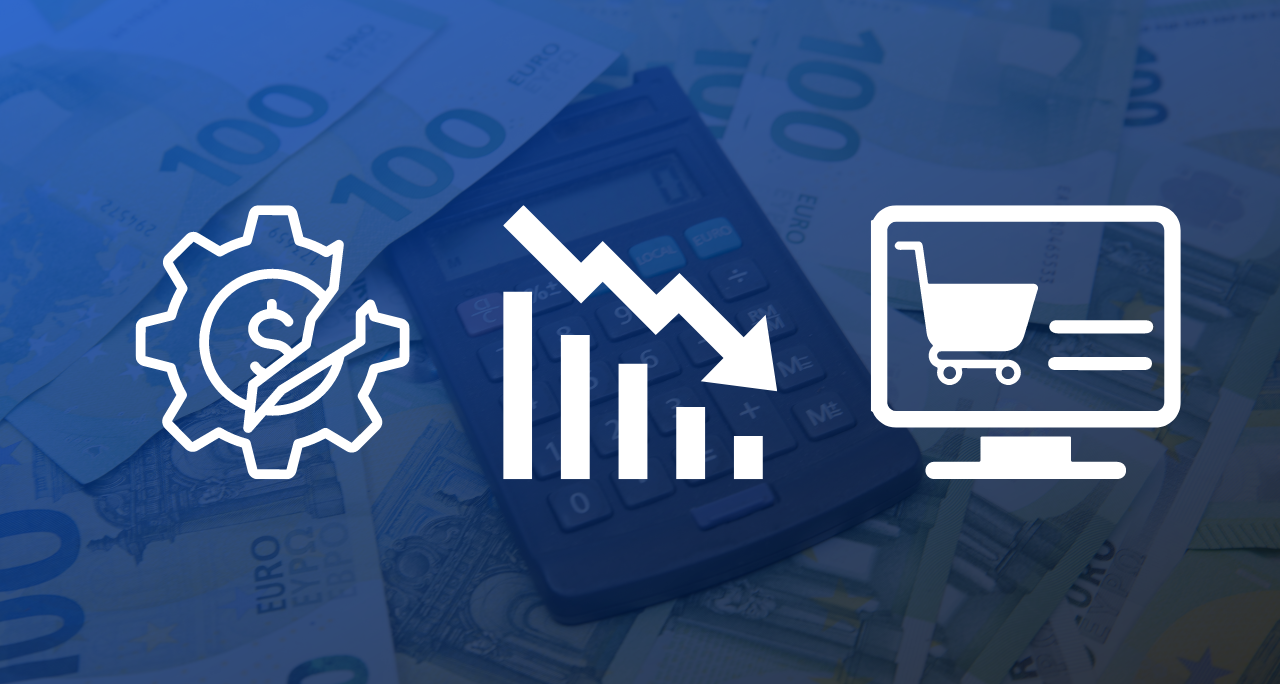The 2023 recession, a global economic downturn driven by various factors, has impacted multiple sectors, including eCommerce. To comprehend its significance, it’s crucial to explore its roots, how it’s unfolding, and its consequent effects.
Triggered by events such as ongoing inflation, geopolitical tensions, and remnants of the COVID-19 pandemic, the recession has disrupted the way businesses function, from supply chains to consumer behavior.

One significant consequence was the price surge across different sectors, including substantial segments in eCommerce, like beauty and apparel. This resulted in double-digit price increases, shaking the eCommerce that was once mainly immune to inflation-induced hikes.
Furthermore, the global supply chain disruptions due to the pandemic and geopolitical events, such as the war in Russia and Ukraine, have had a considerable impact. This is particularly significant for eCommerce, which heavily relies on transport.
Such disruptions are amplified due to a rise in oil prices, affecting industries like transportation, utilities, agriculture, plastics, chemicals/fertilizers, and metals that are highly impacted by higher crude oil prices.
Grasping the implications of the 2023 recession on eCommerce businesses is crucial. This understanding helps these businesses navigate the volatile economic terrain, prepare for future challenges, and strategize effectively for continued operation and growth.
The shifts in the eCommerce landscape necessitate innovative approaches to tackle the resulting challenges and leverage any emerging opportunities.
The Effects of the 2023 Recession and Inflation on eCommerce Businesses
Let’s dive deeper into the economic indicators, changes in consumer behavior, and the disruption of supply chain, to better understand the effects of the 2023 recession and concurrent inflation on eCommerce.

Causes of the Recession and Its Effects on eCommerce
Several key factors have contributed to the 2023 recession, each carrying significant implications for eCommerce:
- Ongoing Global Inflation: This unprecedented inflation trend led to price hikes across various sectors, with eCommerce no exception. Notably, beauty and apparel segments on major eCommerce like Amazon registered double-digit price increases, with a median price increase of 11% and 7%, respectively.
- Geopolitical Tensions: Events such as the war in Russia and Ukraine disrupted global supply chains significantly. This affected industries heavily reliant on international trade, including oil, manufacturing and eCommerce. Emerging economies like Indonesia, Turkey and Brazil were particularly hit hard.
- COVID-19 Pandemic Aftermath: The lingering effects of the global health crisis continued to impact economic stability and consumer confidence. The uncertainty and supply chain disruptions arising from the pandemic severely affected consumer spending habits and the operational capabilities of eCommerce businesses.
Economic Indicators Leading Up to the Recession

Specific economic indicators hinted at the looming economic downturn:
- Inflation Rates: Globally, inflation rates steadily rose, directly impacting the cost of goods and services. This trend was equally evident in eCommerce sectors, with the price surge significantly influencing business models and consumer behavior.
- Unemployment Rates: Increasing unemployment rates indicated a reduction in consumer purchasing power. As more individuals faced job losses, there was an increased inclination towards saving rather than spending, directly affecting eCommerce sales.
- Global Trade Indices: A decline in global trade indices suggested a slowdown in global trade, an indication of the impending recession. This was a cause for concern for eCommerce businesses relying heavily on international supply chains.
- Stock Market Performance: Stock markets across the globe experienced declining performance, typically a precursor to an economic downturn.
Changes in Consumer Behavior and Spending Habits
The 2023 recession brought about significant shifts in consumer behavior and spending habits:
- Increased Tendency towards ‘Recommerce’: In the face of rising online prices, over 90% of U.S. consumers turned to buying and selling pre-owned goods as a cost-saving measure. This trend has led to an increase in the popularity of online platforms specializing in secondhand goods.
- Adoption of ‘Shrinkflation’: Retailers started to reduce package sizes, especially for edible products, as a countermeasure to inflation. This strategy, known as ‘shrinkflation,’ allowed businesses to maintain the price points while reducing the quantity or size of the products.
- Preference for Essential Goods: As discretionary income shrank, consumers prioritized essential goods, cutting back on non-essential spending. This resulted in a noticeable shift in online shopping patterns.
Impact of Supply Chain Disruptions on eCommerce

Supply chain disruptions significantly influence the dynamics of eCommerce operations. Each industry has faced unique challenges, with repercussions for sellers and consumers. Here are some insights into how different sectors have been affected:
1. Electronics: The electronics industry, and in particular, manufacturers of computer chips and semiconductors, have faced significant disruption. With much of the production concentrated in certain regions, any interruption has a domino effect on industries worldwide.
For instance, a global semiconductor shortage has not only affected the production of electronic goods but also increased their pricing due to the basic principles of supply and demand.
2. Fashion and Apparel: The fashion industry has been significantly impacted, as it relies heavily on global supply chains. Challenges include increased prices for raw materials like cotton and silk, delays in shipping, and labor shortages. These factors collectively lead to higher prices for end consumers and longer wait times for product delivery.
3. Food and Beverage: The online grocery segment has seen increased costs due to both inflation and supply chain disruptions. Factors such as increased fuel costs, labor shortages in agriculture and delivery, and packaging material costs have contributed to higher prices and decreased availability of some products.
4. Health and Wellness: During the COVID-19 pandemic, the demand for health and wellness products Also, supply chain disruptions have affected the availability and cost of these products.
Delays in producing and distributing essential items like vitamins and supplements have led to increased prices and longer delivery times.
5. SaaS: While the Software as a Service (SaaS) industry might seem insulated from physical supply chain disruptions, it has not been entirely immune.
These companies have faced challenges such as increased operational costs due to inflation. For example, companies may have to spend more on server space and data centers, costs that could be passed on to the end consumers.
These disruptions highlight the interconnected nature of global supply chains and the significant impacts that disruptions in one sector can have on others.
For eCommerce businesses, understanding and adapting to these challenges is crucial.
Crafting a Recession-Proof Business: Opportunities, Challenges, and Success Stories in eCommerce

The 2023 recession has undoubtedly imposed a challenging landscape for eCommerce businesses. However, such periods of economic turbulence often also present unique opportunities for those able to adapt and optimize their operations. By examining successful practices, businesses can craft strategies to recession-proof their operations, ensuring their resilience amidst the economic downturn.
Opportunities and Challenges during the Recession
The economic downturn has created a paradoxical environment for eCommerce businesses, marked by opportunities and challenges.
Opportunities
- Collaborations and Partnerships: In a rapidly shifting business landscape, partnerships can open new avenues for growth and risk diversification. They offer the opportunity to pool resources and skills, tap into new markets, and benefit from shared knowledge to innovate and stay ahead of the competition.
- Sustainability Initiatives: As consumers increasingly prioritize environmental responsibility, businesses that emphasize sustainability can gain a competitive advantage. By implementing green practices and effectively communicating these efforts, eCommerce businesses can boost their brand image, customer loyalty, and potentially attract a wider customer base.
- Rise of D2C: Direct-to-consumer (D2C) sales are rising, offering businesses the opportunity to cultivate a direct relationship with customers, gain valuable customer data, and improve margins by eliminating intermediaries.
- Evolving Consumer Habits: Changes in consumer habits, accelerated by the pandemic, have created opportunities for businesses that can accurately predict and adapt to these shifts. For instance, the increase in remote work has led to greater demand for home office equipment and comfortable apparel.
- Technology Integration: The integration of technologies like AI, VR, and AR into the shopping experience can enhance customer engagement, provide personalized experiences, and increase conversion rates.
Challenges
- Customer Retention: In a highly competitive market with price-sensitive customers, retaining customers and securing repeat purchases is a challenge. Businesses need to continuously innovate and provide exceptional customer service to stand out.
- Increased Operating Costs: Rising shipping costs, costs of raw materials, and expenses associated with implementing new technologies can significantly increase the operational costs in an eCommerce environment, directly affecting profit margins.
- Navigating Different Markets: As businesses expand globally, they face the challenge of understanding and complying with various market regulations and meeting diverse customer expectations. This necessitates significant research and adaptation.
- Technological Disruptions: With increased reliance on technology, eCommerce businesses face potential threats like cyberattacks, website downtime, or technical glitches. These disruptions can significantly affect customer trust and business operations.
- Maintaining a Strong Brand Identity: In the crowded online marketplace, developing a unique brand identity and differentiating from competitors is challenging. ECommerce businesses must consistently communicate their unique value propositions and create memorable customer experiences.
Recognizing these opportunities and challenges is the first step to crafting an effective strategy for navigating the economic downturn. By doing so, eCommerce businesses can turn the challenges of the 2023 recession into opportunities for growth and success.
Importance of Optimizing Operations during a Recession
Operating efficiency is crucial during a recession. Businesses can offset some of the economic downturn’s impact by reducing time and cost, redistributing resources, and capitalizing on organic marketing. Key focus areas include:
- Cost and Time Efficiency: Implementing lean management techniques can help eliminate waste, streamline processes, and reduce operational costs and time.
- Resource Redistribution: By identifying core competencies and reallocating resources accordingly, businesses can ensure they’re investing in areas with the highest return on investment.
- Organic Marketing: With advertising budgets often slashed during recessions, focusing on organic marketing strategies such as search engine optimization (SEO) and content marketing can provide cost-effective ways to reach customers.
- User Experience (UX) Optimization: By improving the user experience on their platform, eCommerce businesses can enhance customer satisfaction, encourage repeat business, and increase word-of-mouth referrals.
The Inflation Crisis is Reshaping eCommerce: Insights for Retailers
The inflation crisis has undeniably led to reshaping the eCommerce landscape, requiring retailers to adapt to new consumer behaviors and market dynamics. In fact, certain circumstances related to inflation might even fuel the growth of eCommerce.
How eCommerce Could Grow More Strongly Due to Inflation
The current inflationary climate presents several ways in which eCommerce could potentially see robust growth:
- Price Flexibility: ECommerce websites often have more flexibility to adjust prices quickly in response to changing costs, allowing them to stay competitive even in an inflationary environment.
- Lower Overheads: Online businesses typically have lower overheads than brick-and-mortar stores, making them more resilient to inflationary pressures and potentially able to offer more competitive prices.
- Global Market Access: ECommerce platforms can access customers from all over the world. This allows them to take advantage of different economic climates and balance the effects of inflation in one region with stability or growth in another.
- Supply Chain Innovation: ECommerce businesses have the opportunity to innovate and find cost-effective solutions to supply chain disruptions caused by inflation, such as sourcing from alternative suppliers, optimizing logistics, and utilizing dropshipping.
- Increased Demand for Online Shopping: As inflation drives up the cost of goods, consumers may opt for convenience and often lower online shopping prices.
- Advanced Technology Utilization: Through advanced technologies like AI and machine learning, eCommerce businesses can optimize pricing strategies, forecast demand more accurately, and manage inventory more effectively to mitigate the impacts of inflation.
- Dynamic Pricing Strategies: ECommerce businesses can use dynamic pricing strategies to adjust to rapid demand and supply changes and manage customer expectations in times of inflation.
- Shift towards Value-based Shopping: With rising prices, consumers may seek out brands that offer the best value for money. Online merchants that can demonstrate value—through quality, service, or unique selling propositions—may therefore see increased growth.
While inflation poses significant challenges, these points illustrate how eCommerce businesses can potentially leverage this environment for more substantial growth. They can manage inflationary pressures by adopting strategic measures and turning these challenges into opportunities.
Case Studies of Successful eCommerce Adaptations to the Inflation Crisis
Let’s dive deeper into the strategies employed by Shein and Aldi, which have allowed these companies to successfully navigate the inflation crisis.
Shein

Shein has become a leading name in the eCommerce fashion industry mainly because of its quick adaptation to market trends and consumer demands.
When inflation began to impact consumer purchasing power, Shein was agile enough to adjust its offerings, focusing on lower-cost yet trendy products.
This strategic maneuver was possible due to their tight control over their supply chain, which reduced costs and allowed rapid adjustment to fashion trends. This aligns with our earlier point on the importance of optimizing operations.
By managing its supply chain efficiently, Shein could control their costs and adjust their product offerings quickly, ensuring their continued appeal despite economic headwinds.
Aldi

Aldi’s success story presents a classic case of how focusing on cost-efficiency and customer value can aid growth during a recession. Aldi operates on a low-cost, high-efficiency model that provides quality goods at affordable prices.
Amidst the inflation crisis, Aldi continued to deliver on this value proposition by streamlining their product selection and optimizing operations to keep overhead costs low. Providing high-quality products at low costs has helped Aldi maintain a consistent customer base even during inflationary periods.
Aldi’s success emphasizes the importance of resource redistribution and operational efficiency in weathering an economic downturn.
These success stories illustrate that while the inflation crisis presents challenges, it also opens up opportunities for eCommerce businesses to adapt, innovate, and thrive. The key lies in understanding and responding to the new economic realities quickly and efficiently.
Conclusion
As we’ve seen throughout this analysis, the 2023 recession and inflation have brought about significant shifts in the eCommerce landscape. While challenging, these shifts also present unique opportunities for businesses that are able to adapt effectively.
Price surges and supply chain disruptions have become defining features of the current economic climate, influencing consumer behaviors and business strategies.
Yet, despite these obstacles, some businesses have successfully navigated the crisis by optimizing their operations, streamlining processes, and focusing on cost and operational efficiency.
FinTech companies have also played a significant role in helping eCommerce merchants navigate these changes. By providing innovative solutions for payment processing, inventory management, and predictive analytics, FinTechs are helping to equip businesses with the tools they need to succeed in this new economic landscape.
As we continue to grapple with the impacts of the 2023 recession and inflation, it’s crucial for eCommerce businesses to take proactive steps to prepare for and adapt to these changing conditions. This may involve embracing new technologies, refining marketing strategies, and prioritizing operational efficiency.
In the face of these economic headwinds, the following strategies may help to recession-proof your business:
- Focus on Operational Efficiency: Streamline your processes and eliminate waste to keep costs low and competitive.
- Optimize Your Supply Chain: Take proactive measures to mitigate the impact of supply chain disruptions.
- Prioritize Customer Value: Delivering high-quality products at competitive prices can set your business apart in a price-sensitive market.
- Embrace Digital Transformation: Utilize technology to improve your business operations and customer experience.
In conclusion, while the 2023 recession and inflation crisis present significant challenges, they also open up new avenues for growth and innovation. By adopting a strategic, flexible approach, eCommerce businesses can navigate these tumultuous times and emerge stronger on the other side.





